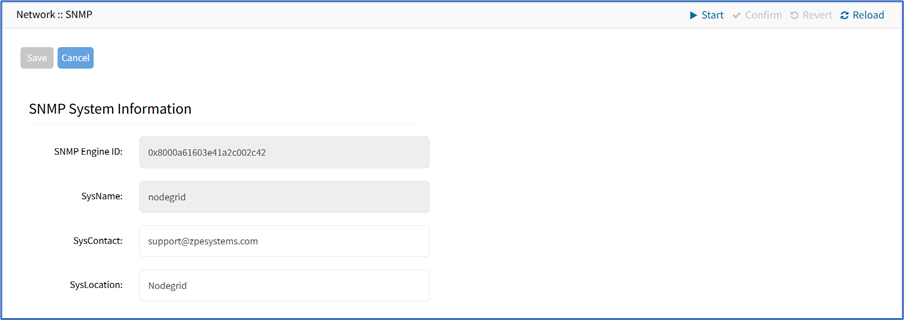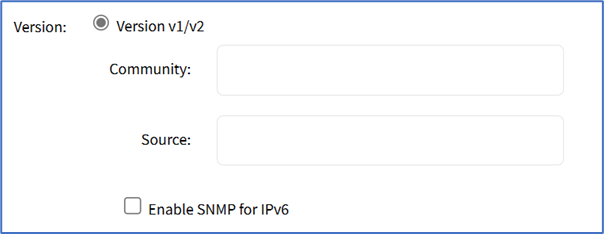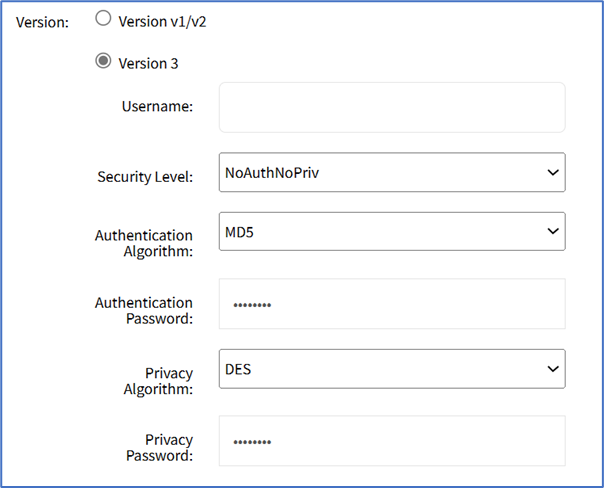Review/edit System Information
- Go to Network :: SNMP.
- Click System (displays dialog).

- Two fields can be edited:
- SysContact (email address)
- SysLocation (location name)
- If changed, click Save.
- If not, click Cancel to return to table.
Add SNMP Community/Username Configuration
- Go to Network :: SNMP.
- Click Add (displays dialog).

- In the Version menu (select one):
- Version V1/V2 radio button (expands dialog). Enter Community and Source. (if applicable) Enable SNMP for IPv6 checkbox.

- Version 3 radio button (expands dialog):
 Enter Username.
Enter Username.
On Security Level drop-down, select one (NoAuthNoPriv, AuthNoPriv, AuthPriv).
On Authentication Algorithm drop-down, select one (MD5, SHA, SHA-224, SHA-256, SHA-384, SHA-512).
Enter Authentication Password.
On Privacy Algorithm drop-down, select one (DES, AES, AES-192, AES-256).
Enter Privacy Password
- Version V1/V2 radio button (expands dialog). Enter Community and Source. (if applicable) Enable SNMP for IPv6 checkbox.
- On OID menu:
- OIDs and Descriptions are:
- ngCellularConnections (OID: .1.3.6.1.4.1.42518.4.2.1.1.7)
DESCRIPTION: This is the root for cellular connections. - ngCellularNumOfConnections (OID: .1.3.6.1.4.1.42518.4.2.1.1.7.1.0)
DESCRIPTION: This object contains number of Cellular Connections. This identifies the number of Cellular Connections. - ngCellularConnectionsTable (OID: .1.3.6.1.4.1.42518.4.2.1.1.7.2)
DESCRIPTION: This table has information about Cellular Connections in this unit. - ngCellularConnectionsEntry (OID: .1.3.6.1.4.1.42518.4.2.1.1.7.2.1)
DESCRIPTION: An entry for each Cellular Connection plugged in this unit. Each entry contains information on connection status, slot, SIM, data consumption and signal strength. - ngCellularConnectionNumber (OID: .1.3.6.1.4.1.42518.4.2.1.1.7.2.1.1)
DESCRIPTION: This object unique identifies Cellular Connection Index. - ngCellularConnectionSlot (OID: .1.3.6.1.4.1.42518.4.2.1.1.7.2.1.2)
DESCRIPTION: Slot of the Cellular Connection. - ngCellularConnectionInterface (OID: .1.3.6.1.4.1.42518.4.2.1.1.7.2.1.3)
DESCRIPTION: Interface of the Cellular Connection.
ngCellularConnectionStatus (OID: .1.3.6.1.4.1.42518.4.2.1.1.7.2.1.4)
DESCRIPTION: Status of the Cellular Connection. - ngCellularConnectionSIMState (OID: .1.3.6.1.4.1.42518.4.2.1.1.7.2.1.5)
DESCRIPTION: State of the SIM Card of the Cellular Connection. - ngCellularConnectionSIMActive (OID: .1.3.6.1.4.1.42518.4.2.1.1.7.2.1.6)
DESCRIPTION: Number of the Active SIM Card of the Cellular Connection. - ngCellularConnectionDataConsumption (OID: .1.3.6.1.4.1.42518.4.2.1.1.7.2.1.7)
DESCRIPTION: Data Consumption in kBytes of the Cellular Connection. - ngCellularConnectionOperator (OID: .1.3.6.1.4.1.42518.4.2.1.1.7.2.1.8)
DESCRIPTION: Operator of the Cellular Connection. - ngCellularConnectionRadioMode (OID: .1.3.6.1.4.1.42518.4.2.1.1.7.2.1.9)
DESCRIPTION: Radio Mode of the Cellular Connection. - ngCellularConnectionSignalStrength (OID: .1.3.6.1.4.1.42518.4.2.1.1.7.2.1.10)
DESCRIPTION: Signal Strength of the Cellular Connection in percent. - ngCellularConnectionTemperature (OID: .1.3.6.1.4.1.42518.4.2.1.1.7.2.1.11)
DESCRIPTION: Temperature of the Cellular Connection device.
- ngCellularConnections (OID: .1.3.6.1.4.1.42518.4.2.1.1.7)
- On Access Type drop-down, select one (Read and Write, Read Only)
- OIDs and Descriptions are:
- Click Save.
Edit Community/Username
- Go to Network :: SNMP.
- On Community or Username column, click a name (displays dialog).
- Make changes, as needed.
- Click Save.
Delete Community/Username
- Go to Network :: SNMP.
- Select checkbox to be deleted.
- Click Delete.